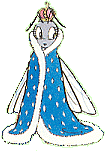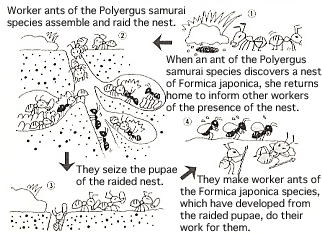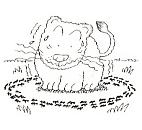
Worker ants that never work?
In the antsユ world, worker ants ordinarily forage food and care for eggs, larvae and the queen of each nest. However, the ants of one species allow ants of other species to do all of their work for them even though they are worker ants. This lazy ant species is Polyergus samurai. |
|||
|
A crowd of ants of the Polyergus samurai species raiding a nest of Formica japonica: These ants make raids in large メarmiesモ on nests of other species every summer. |
Ants of the Polyergus samurai species pulling out larvae and pupae of the Formica japonica species from the entrance of the nest they have raided. | ||
|
Around the period from July to September every year, worker ants of the Polyergus samurai species assemble and raid the nests of Formica japonica. They fight by using their sharp, sickle-shaped jaws to frighten and attack the ants of the Formica japonica species, until they seize the larvae and pupae of the raided nest. They carry these back to their nest and stow them carefully. In time, the larvae and pupae of Formica japonica species develop into adults and are forced to spend their lives working for Polyergus samurai. Ants of the Polyergus samurai species work only when they raid the nests of Formica japonica. At times other than when they raid the nests of Formica japonica, Polyergus samurai ants do not work, but in contrast, force their slaves, worker ants of the Formica japonica species, carry out all of their work. |
An ant of the Polyergus samurai species with strong, sharp jaws. | ||
| Slave-making by ants of the Polyergus samurai species | |||
 |
|||
|
Fierce army ants |
|||
 Some
ants are nomadic and wander in a gypsy-like fashion around the countryside,
never building permanent nests but occupying temporary shelters. When they
encounter a food source, they devour it. This ant species is the army or
legionary ant living in South America, which is commonly called the driver
ant in Africa. Some
ants are nomadic and wander in a gypsy-like fashion around the countryside,
never building permanent nests but occupying temporary shelters. When they
encounter a food source, they devour it. This ant species is the army or
legionary ant living in South America, which is commonly called the driver
ant in Africa.Ant メarmiesモ consisting of as many as one million individuals carry out hunting raids for food. These ants set out from the temporary shelter in various directions and attack not only living insects, but also lion cubs and other such food sources. |
|||